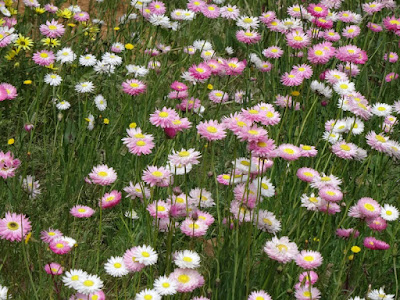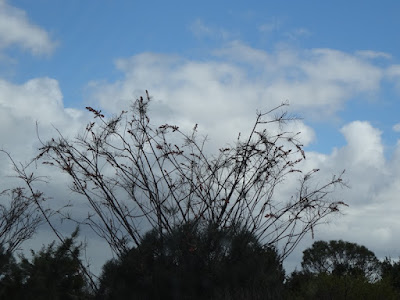The little town of Coorow lies in the heart of what is billed as Wildflower Country. Naturally, that made it an obvious target for our wildflower-watching expedition on September 17, 2013.
Our first stop on arrival after our morning drive (see my three previous posts) was the town visitor's centre. Here we learned that there was a site for Wreath Leschenaultia, or Wreath Plant (Leschenaultia macrantha), some distance to the east - so although we had seen them yesterday, there was nothing for it but to detour eastwards for another look.
Our drive took us past flower-filled farmers' fields, eastward to the dry country the Wreath Plants prefer.
The site, once we reached it, was rather different from the broad, sandy road shoulders where we had found Wreath Plants the day before - dry, to be sure, but hilly and eroded. we had to hunt around a bit to find the plants themselves.
Our first stop on arrival after our morning drive (see my three previous posts) was the town visitor's centre. Here we learned that there was a site for Wreath Leschenaultia, or Wreath Plant (Leschenaultia macrantha), some distance to the east - so although we had seen them yesterday, there was nothing for it but to detour eastwards for another look.
Our drive took us past flower-filled farmers' fields, eastward to the dry country the Wreath Plants prefer.
The site, once we reached it, was rather different from the broad, sandy road shoulders where we had found Wreath Plants the day before - dry, to be sure, but hilly and eroded. we had to hunt around a bit to find the plants themselves.
When we finally did, they proved to be smaller and less numerous than at our earlier site, but lovely nonetheless.
The other flowers in the neighbourhood included carpets of Orange Immortelle (Waitzia acuminata)...
The other flowers in the neighbourhood included carpets of Orange Immortelle (Waitzia acuminata)...
...and Bottlebrush Grevillea (Grevillea paradoxa). Perhaps the specific name 'paradoxa' refers to its paradoxical combination of soft pink flowers and odd, spiky-looking leaves. This species, which ranges south and west along the edge of the Western Australian wheatbelt, is considered to be one of the most attractive of the grevilleas,
There wasn't much wildlife in sight, but this little termitarium is evidence of, probably, a lot of animal (or at least insect) activity below ground.
Our passion for Wreath Plants satisfied, we drove back west to Coorow for some food and petrol. While filling up, we noticed that Tree Martins (Petrochelidon nigricans), the drabbest of Australia's native swallows, were nesting in the corrugated iron roof over the fuel pumps. Tree Martins have become adapted to nesting among humans, but originally nested (and still nest, away from town) in tree cavities or rock hollows.
Splendid, or Pink-and-white, Everlasting (Rhodanthe chlorocephala) is probably the most spectacular, and is certainly the most popular. It flowers after rain, usually in the austral spring, but it will bloom at other times of the year if the conditions are right. In botanical terms it is an ephemeral, a dry country plant that springs up quickly, lives only long enough to cast out its seeds, and withers again when the dry weather reasserts itself.Our passion for Wreath Plants satisfied, we drove back west to Coorow for some food and petrol. While filling up, we noticed that Tree Martins (Petrochelidon nigricans), the drabbest of Australia's native swallows, were nesting in the corrugated iron roof over the fuel pumps. Tree Martins have become adapted to nesting among humans, but originally nested (and still nest, away from town) in tree cavities or rock hollows.
The Willie-Wagtail (Rhipidura leucophrys), a species of fantail, is another bird that has adapted to the human world - though recent information suggests that its numbers, like those of many common or once-common Australian birds, are falling.
For our companions, the most exciting flowers in Australia (after the Wreath Plant) were the stiff-flowered daisies known as everlastings. We sought them avidly, and Coorow was, to our delight, full of them - whether by accident or design, I cannot say (they are widely planted).
For our companions, the most exciting flowers in Australia (after the Wreath Plant) were the stiff-flowered daisies known as everlastings. We sought them avidly, and Coorow was, to our delight, full of them - whether by accident or design, I cannot say (they are widely planted).
Coorow, of course, is in a settled, agricultural area, and has its share of foreign weeds. Thread Iris (Moraea setifolia) is a native of southern Africa, where it is one of many beautiful and unusual bulbous plants.
From Coorow we drove south, past more flower-covered (or, more likely, exotic-weed-covered) fields outlined by the spindly silhouettes of eucalyptus trees.
The weird-looking outlines of Yellow Plume Grevillea (Grevillea eriostachya) stood out against the sky. Its strange, dry castanet-like capsules make it look even odder in fruit than in flower.
Equally, if not more, striking were the creamsicle-coloured flower heads of Acorn Banksia (Banksia prionotes). Acorn Banksia is more of a small tree than a shrub; it can reach ten metres in height in some areas. It is prized as an ornamental, and the Australian native Plants Society considers it ideal for the cur flower trade.From Coorow we drove south, past more flower-covered (or, more likely, exotic-weed-covered) fields outlined by the spindly silhouettes of eucalyptus trees.
The road on the way was lined with local shrubs and small trees, including Blakely's Wattle (Acacia blakelyi).
That was a point not lost on the owners of our next stop, the Western Wildflower Farm just outside of Coomberdale, where we saw rows of cut stems of banksias and other plans being dried for sale and export.
I prefer Acorn Banksia flowers on the tree, myself, but I was bemused to see flowers we had come so far to experience in the wild packed away in cardboard boxes for shipment around the world.
































No comments:
Post a Comment